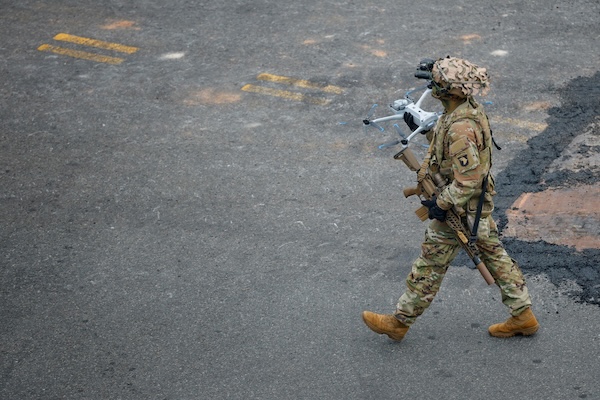 A member of the military holds a drone during the US Army's 250th Birthday parade in Washington, DC, US, 14 June 2025;
Credit: REUTERS/Brian Snyder/File Photo
A member of the military holds a drone during the US Army's 250th Birthday parade in Washington, DC, US, 14 June 2025;
Credit: REUTERS/Brian Snyder/File Photo
WASHINGTON (Reuters) - US President Donald Trump wants a pay raise for troops, more high-tech missiles and drones in next year's defence budget, while cutting Navy jobs, and buying fewer ships and fighter jets to save money, according to budget materials posted Wednesday 25 June 2025.
At $892.6 billion, the defence and national security budget request is flat compared with this year.
The budget, which also includes nuclear weapons-related activities carried out by the Department of Energy and increases funding for homeland security, puts Trump's mark on the military by pulling funds away from weaponry and services to fund his priorities.
The White House said the funding will be used to deter Chinese aggression in the Indo-Pacific, and revitalise the defence industrial base.
Most of the funding for Trump's marquee Golden Dome missile defence shield was included in a separate budget request and is not part of the latest proposal sent to Congress.
In the 2026 budget Trump requested fewer F-35 jets made by Lockheed Martin and only three warships. Procurement of a Virginia-class made by General Dynamics and Huntington Ingalls Industries and fifteen other ships are expected to be included in a separate appropriation bill, the Navy said.
The budget asks for a 3.8% pay raise for troops, but also trims costs by retiring older weaponry including ships and planes that are more expensive to operate. Under the plan, the Navy will reduce its civilian employee workforce by 7,286 people.
Compared to Biden's budget from his last year in office, which had asked for 68 F-35 jets in fiscal 2025, Trump's fiscal 2026 request seeks only 47 of the fighter jets.
The budget has already sparked debate on Capitol Hill where the House Appropriations Committee's Defense subcommittee's draft bill for fiscal-year 2026 boosts the F-35 buy to 69, one more than Biden's 2025 request.
The Pentagon continues prioritising purchasing munitions and key weapons systems.
The Air Force is continuing its investment the Joint Air to Surface Standoff Missile - Extended Range and Long Range Anti-Ship missile which have longer ranges and can be more effective in the Pacific.
On the other hand, the budget seeks far fewer Precision Strike Missile, which will replace the Army Tactical Missile (ATACM) used in Ukraine.
Lockheed Martin makes all three missiles.
The budget also boosts spending on small drones - in part because of lessons learned in Ukraine where unmanned aircraft have proven to be an integral part of low-cost, yet highly effective warfighting.
The detailed request comes as Republicans debate defence spending priorities in their sweeping $150 billion defence package contained in the pending "One Big Beautiful Bill Act". The act has already been passed the House of Representatives and will give an initial $25 billion boost to Trump's controversial Golden Dome missile defence shield.
Defence spending usually accounts for about half of the US discretionary budget; the rest goes to transportation, education, diplomacy and other departments.








